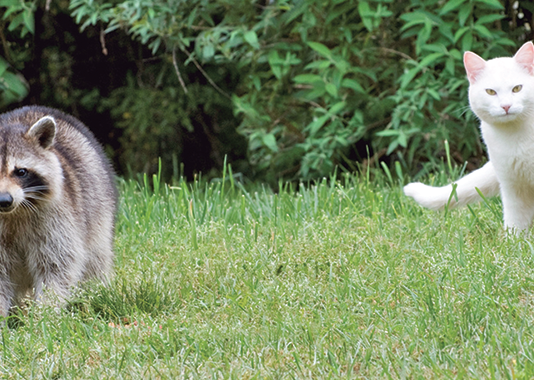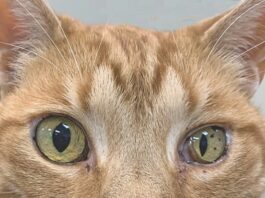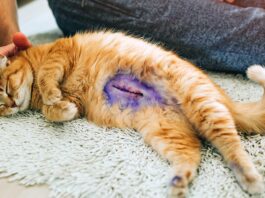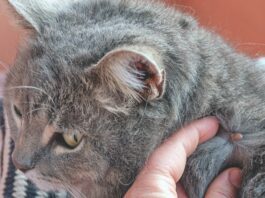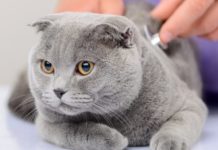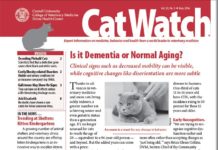An Exciting New Frontier in Medicine
Your arthritic cat walks stiffly, and its difficult to find a medication to treat him without side effects. Could stem cell therapy be an option? Its use in human medicine has grown in the past decade, heralded as a promising treatment for a host of diseases. The latest area of pioneering research, according to the National Institutes of Health, is adult-derived stem cells for repair of the heart.
No Surprise: Canine Flu Jumps Species to Cats
At last count, at least four cats at a Northwest Indiana animal shelter have tested positive for canine influenza - one of the first times the flu strain H3N2 has jumped species in the U.S. Other cats and dogs at the Humane Society Calumet Area showed similar signs of the respiratory disease, as well as lip smacking and excessive salivation, and the shelter temporarily closed.
Fewer Heartworm Cases, More Severe Signs
Cats are less commonly infected by heartworms than dogs, and approximately 80 percent of infected cats clear the infection without signs of disease, but studies have shown the incidence of infection to be greater than previously thought. One study found that between 2 and 5 percent of shelter cats were harboring heartworms. Other statistics show that the prevalence of heartworm disease in cats likely approaches 5 percent, and that it can even occur in cats living indoors.
Will Her Kitten with Distemper Virus Improve as He Ages?
We adopted the cutest little kitten from our local shelter last month. Bob apparently was exposed to feline distemper virus and, as a result, he wobbles and shakes when he walks, and falls over when he plays. He gets the most adorable determined look on his face when he wants to do something - and although it may take him longer to accomplish a task, we cant help but admire his persistent, sunny nature. Can you tell me about this condition he has and will he show any signs of improvement as he ages?
Study Finds Treatment for a Form of Epilepsy
Researchers at the University College of London School of Pharmacy and neurologist Dr. Mark Lowrie at Davies Veterinary Specialists in Hertfordshire in the U.K. previously identified an epilepsy syndrome in geriatric cats. They named it Feline Audiogenic Reflex Seizures (FARS), a condition triggered by high-pitched sounds such as crinkling tin foil and clanging metal spoons.
Recognizing Pancreatitis in Cats
Feline pancreatitis has always been difficult to detect and treat. At least one study, now nearly a decade old, found that the potentially deadly disease might affect more than 60 percent of cats, yet only a small percentage are ever diagnosed. The reasons lie in the widely varying characteristics and unknown elements of the disease, in which the pancreas becomes inflamed. Some cats will display only mild signs such as lack of appetite and lethargy, while growing evidence suggests that many cats with chronic pancreatitis show no symptoms at all.
International Experts Identify Signs of Pain
These are among key 25 signs of pain in cats identified in research at the University of Lincoln in the U.K. Dr. Isabella Merola and Daniel Mills, Professor of Veterinary Behavioral Medicine, surveyed international academics and practitioners with specialties in internal medicine, anesthesiology, oncology, dentistry, behavior, dermatology, ophthalmology and neurology. They say in PLOS One that the resulting list could lead to faster diagnoses and ultimately reduce suffering.
When Compounding Is Right for Your Cat
Hrudey was in trouble. The 7-year-old cat had been diagnosed with both kidney disease and hypertrophic cardiomyopathy, the most common form of heart disease in cats. The double whammy made it difficult to manage his health because of the need to balance the fluids necessary for kidney health with the diuretics that helped control his heart disease. On top of that, of course, his feline nature meant that he wasnt fond of taking medication.
How Could He Be So Normal One Day and So Sick the Next?
FIV is transmitted primarily by bite wounds, as it is found in high concentrations in the saliva of infected cats. For this reason, it is possible to house FIV infected cats with non- infected cats without an extremely high risk of transmission as long as the cats do not fight. FIV affects a cats ability to mount an immune response against infectious organisms, thereby making infected cats more susceptible to infections by viruses, bacteria and fungi.
Does My Cat Have Dementia?
Some cats develop cognitive dysfunction syndrome (CDS), similar to Alzheimers disease in humans. One-third of cats 11 to 14 years old have CDS, with the incidence rising to 50 percent for those 15 years and older.
Download the Full May 2016 Issue PDF
Advances in treatments are helping people born with congenital heart disease live longer and with greater quality of life. But not all structural problems with the heart can be permanently fixed in childhood. In fact, many treatments that help get these patients into adulthood often need revisiting later in life. Being born with congenital heart disease means being always mindful of your heart health. Some of these individuals, because they have been heart patients their whole lives, are mindful of their diet, exercise and risk factor control.
Gallstones May Show No Signs
Cats dont develop gallstones the way we do. Ours are made from cholesterol. Cats stones usually consist of calcium and a bile pigment called bilirubin. However, just as in people, cats can have gallstones without any symptoms or ill effects. Unless a cat has an X-ray or ultrasound for some reason, his owner might never know he had the disorder.

